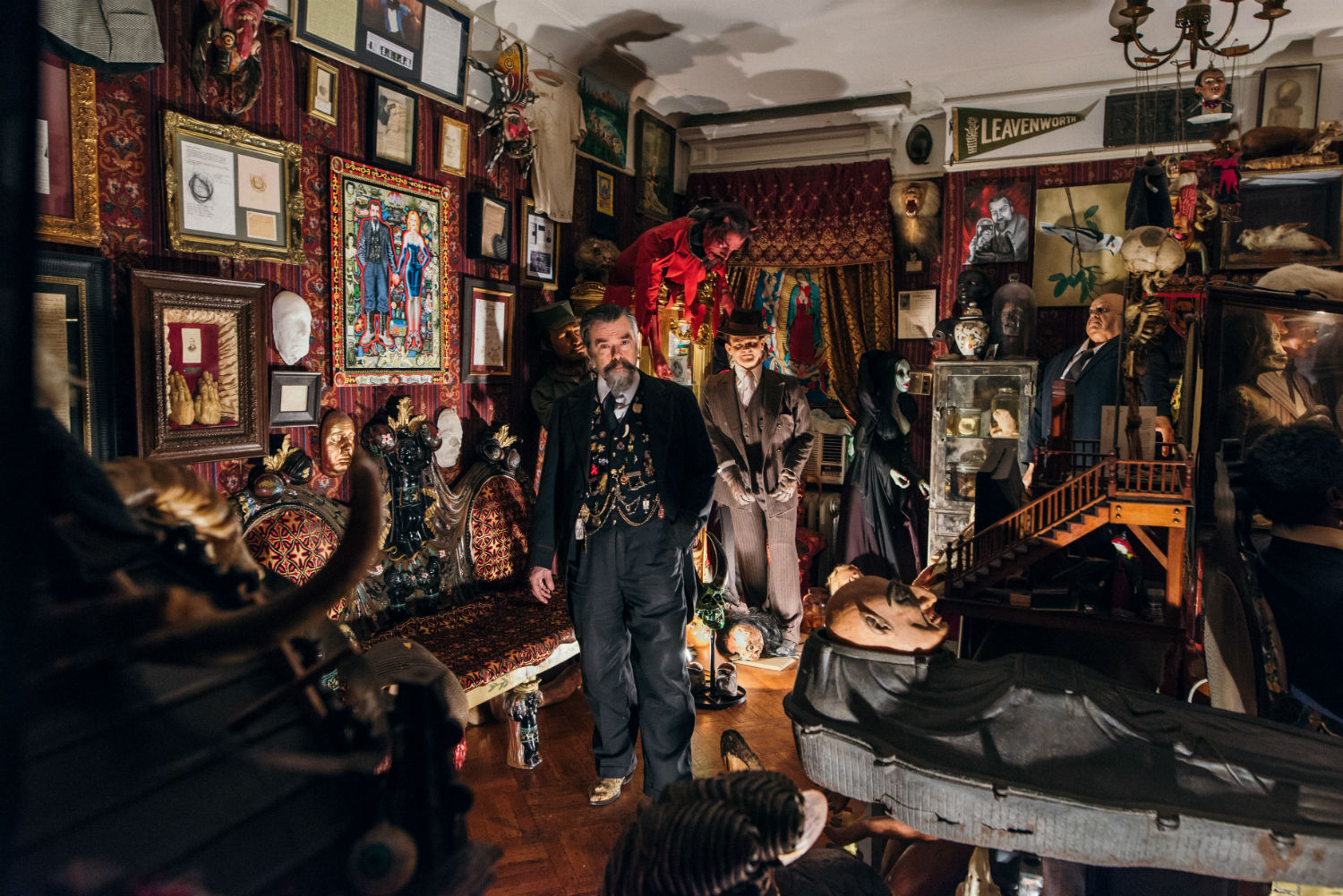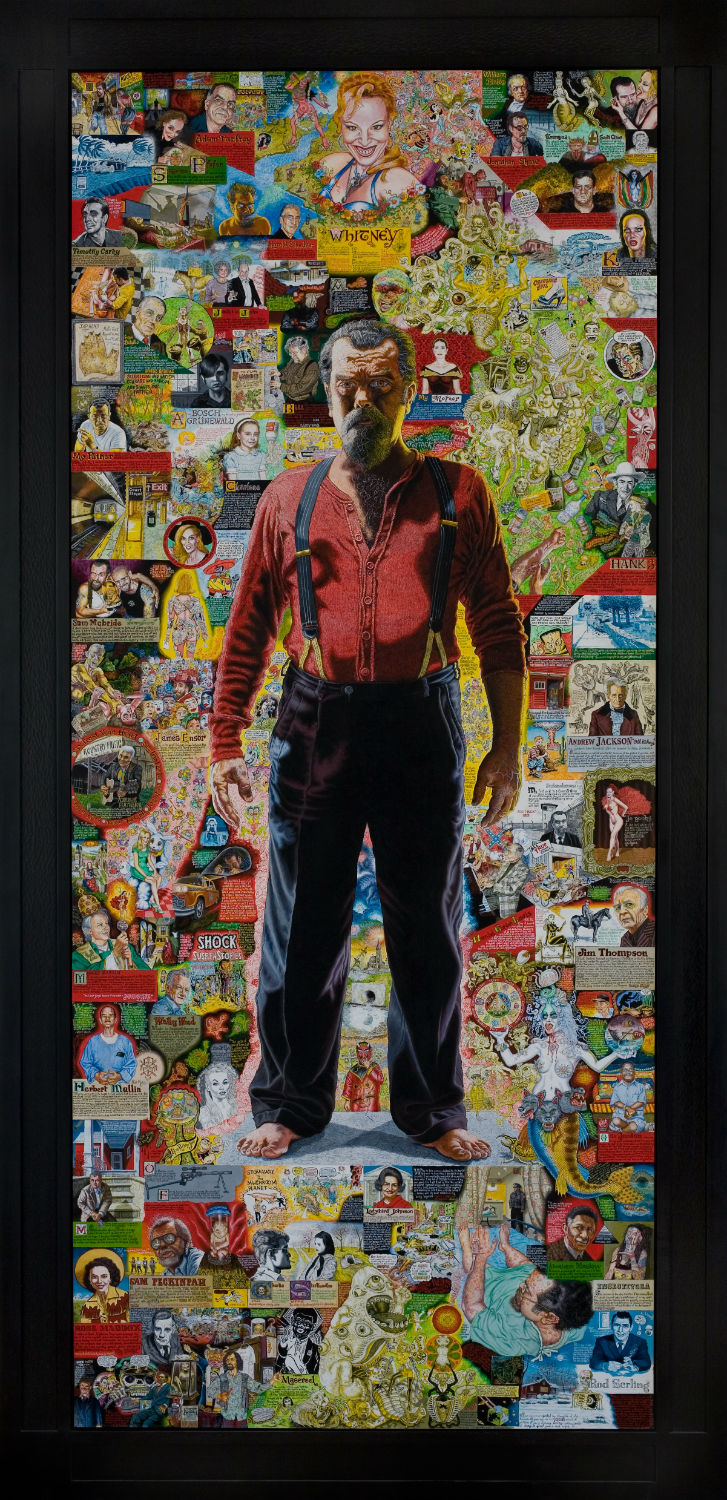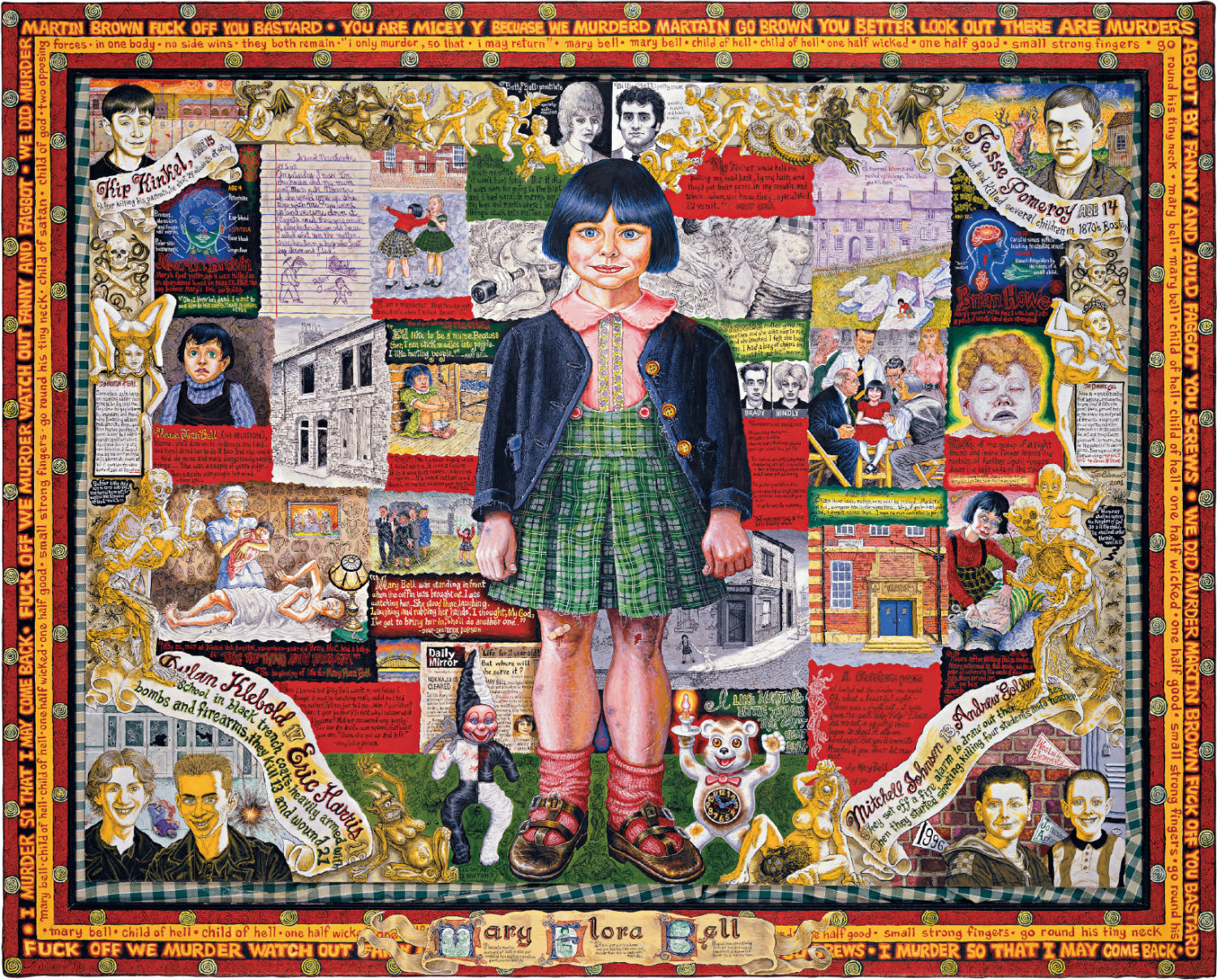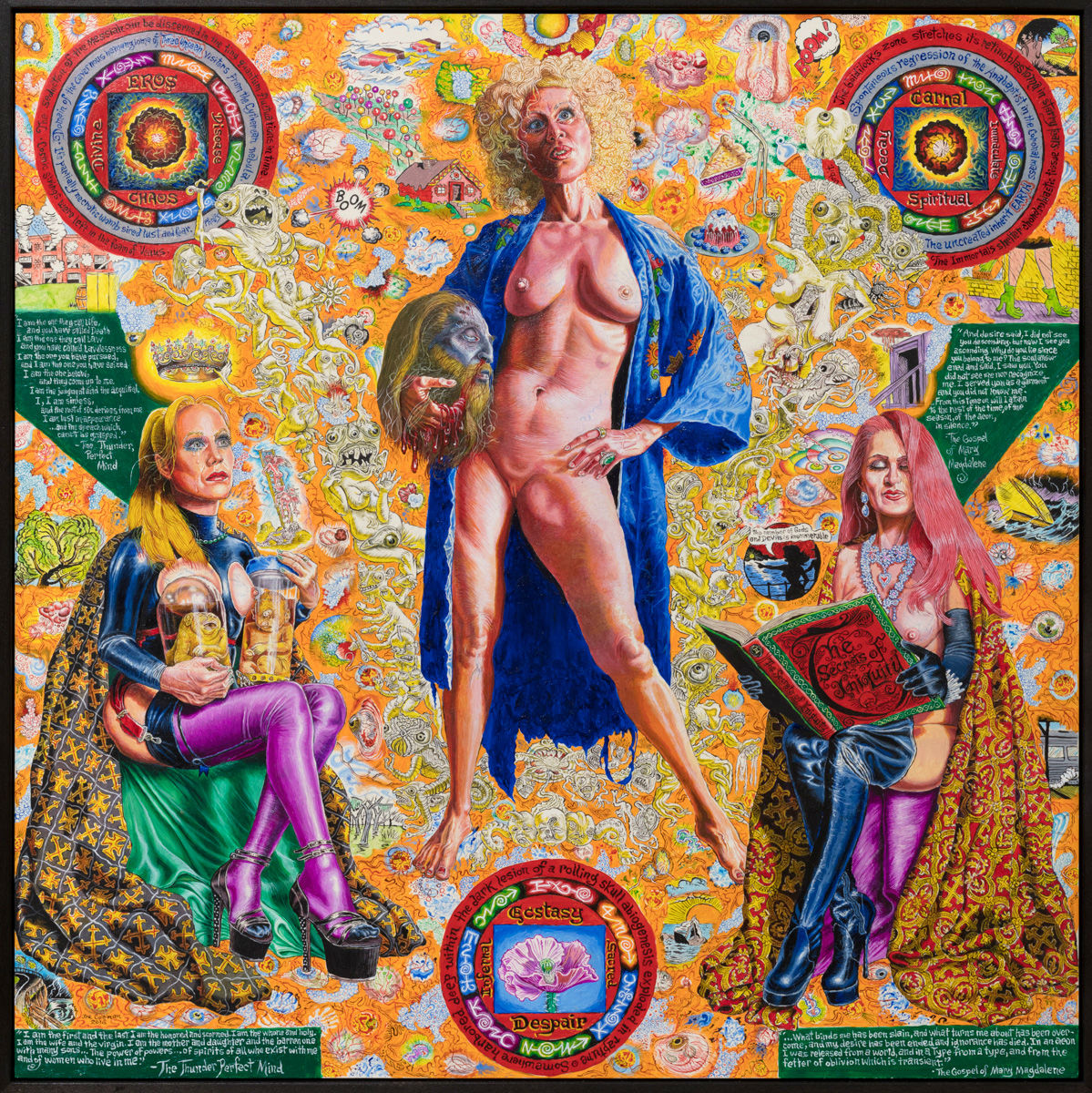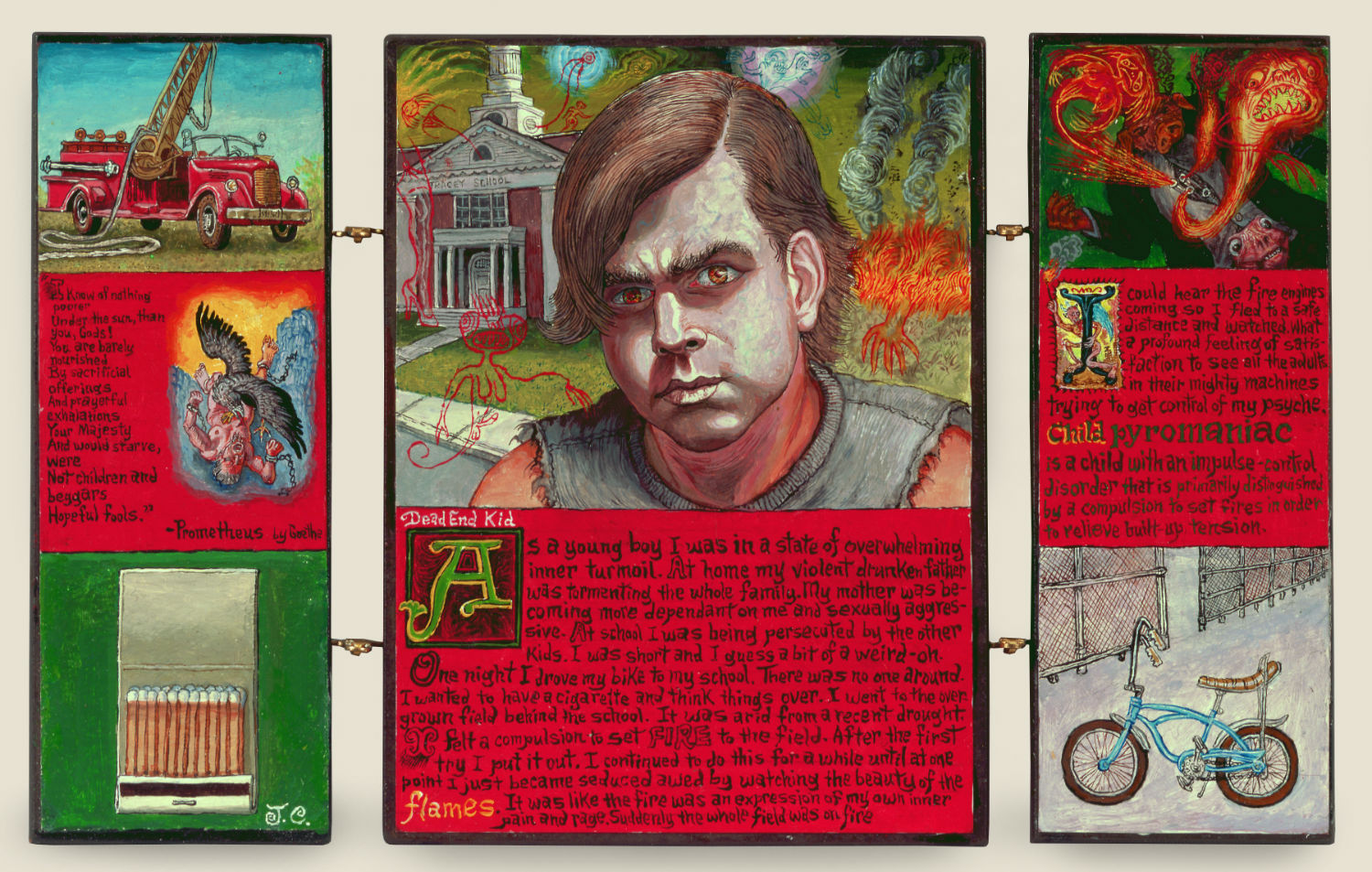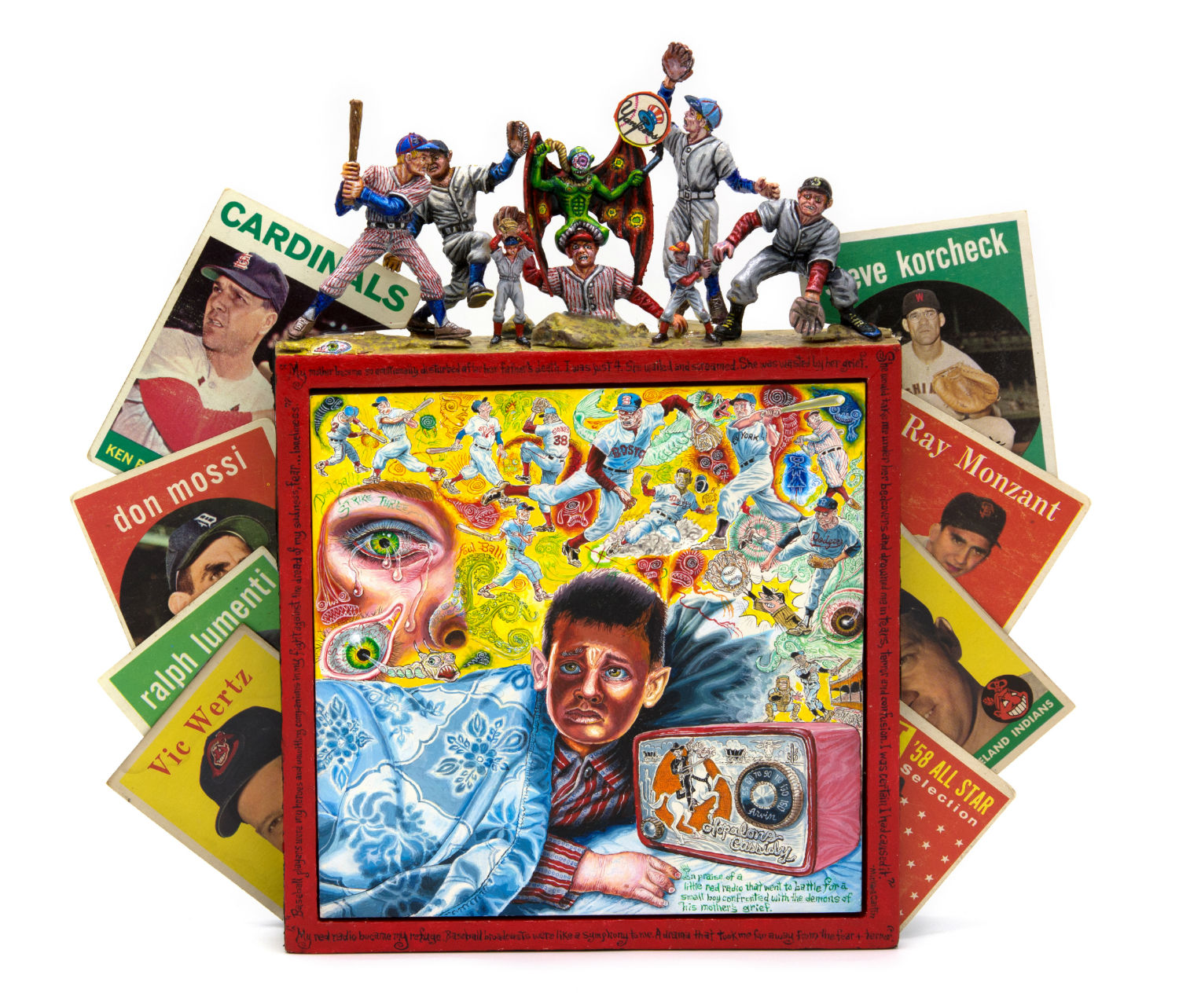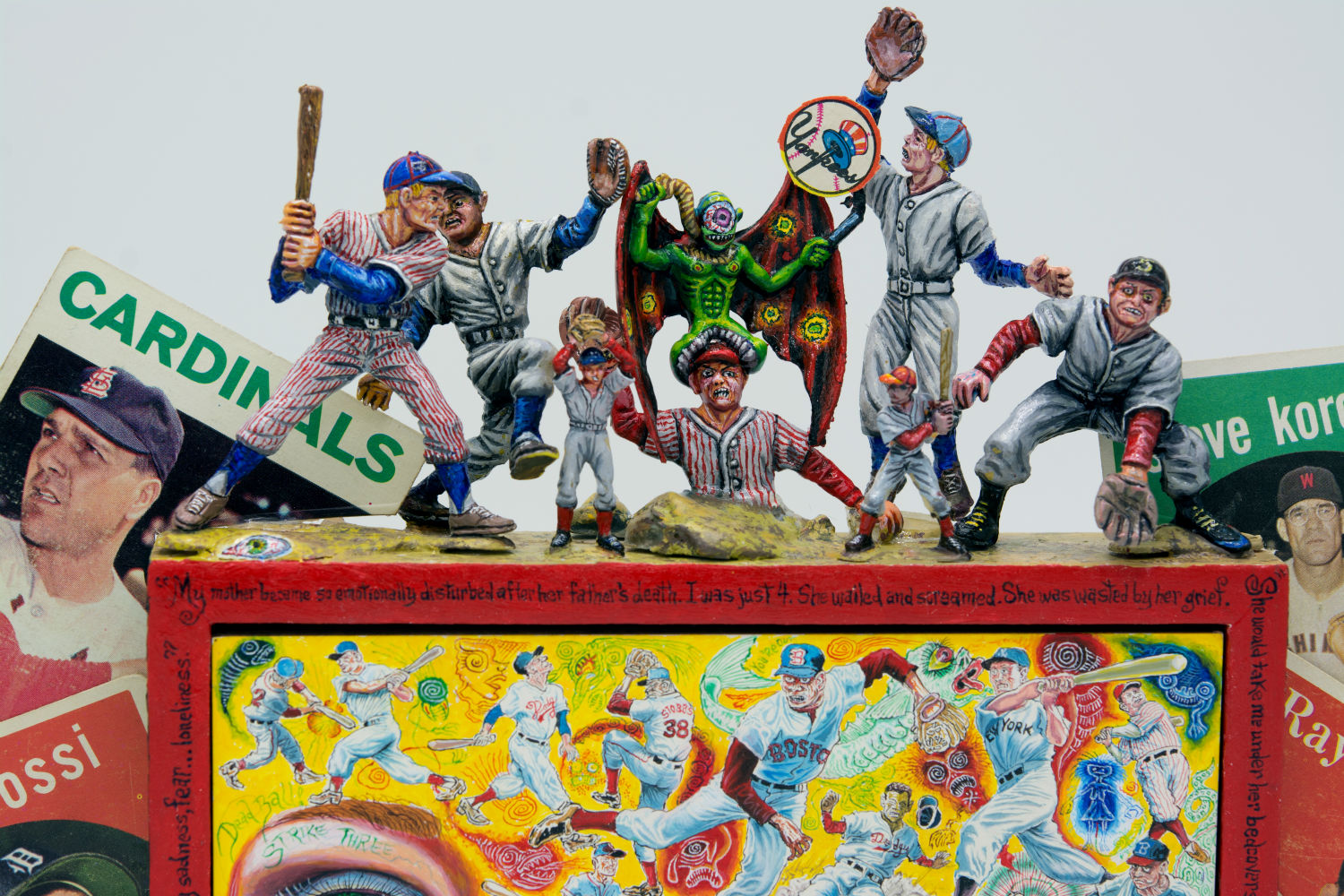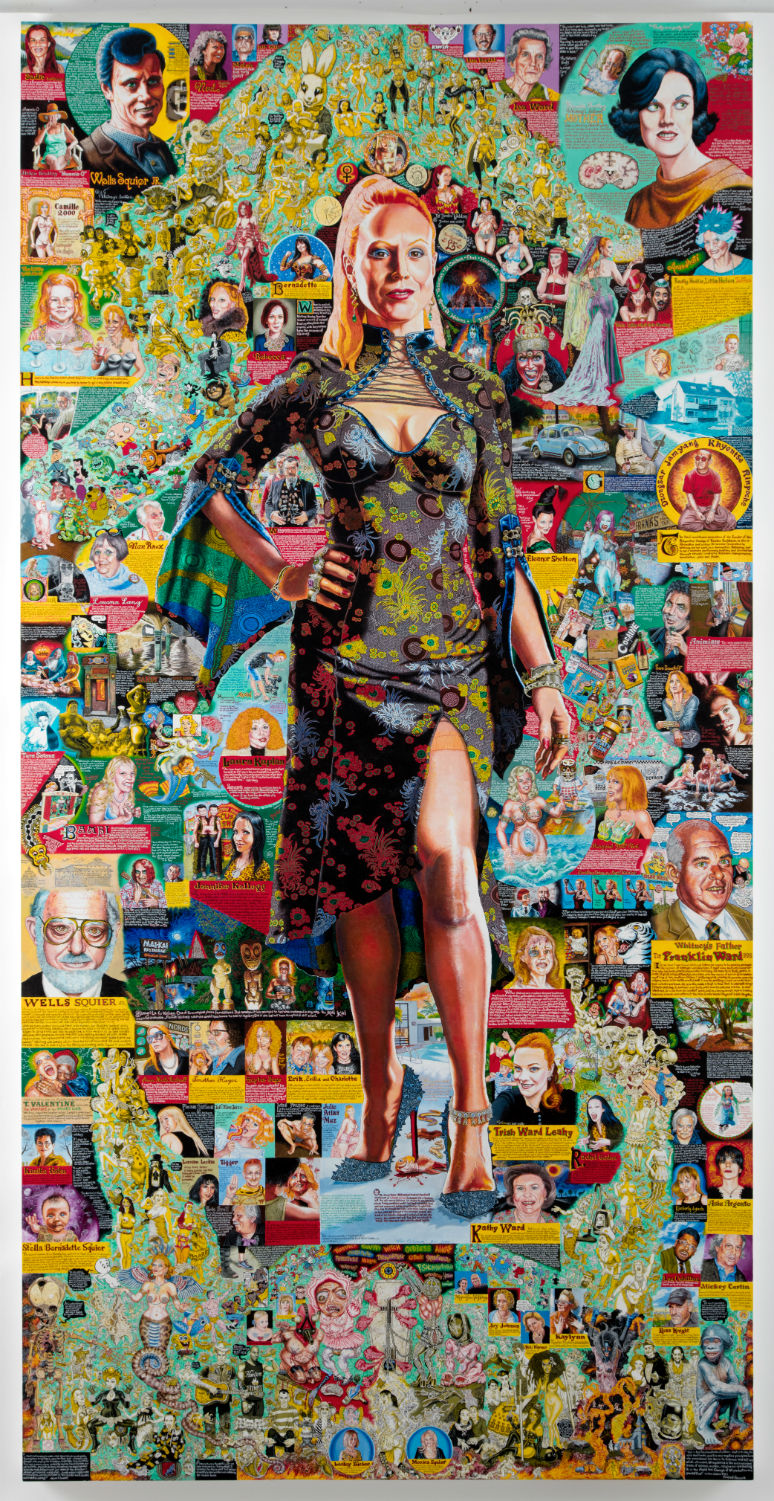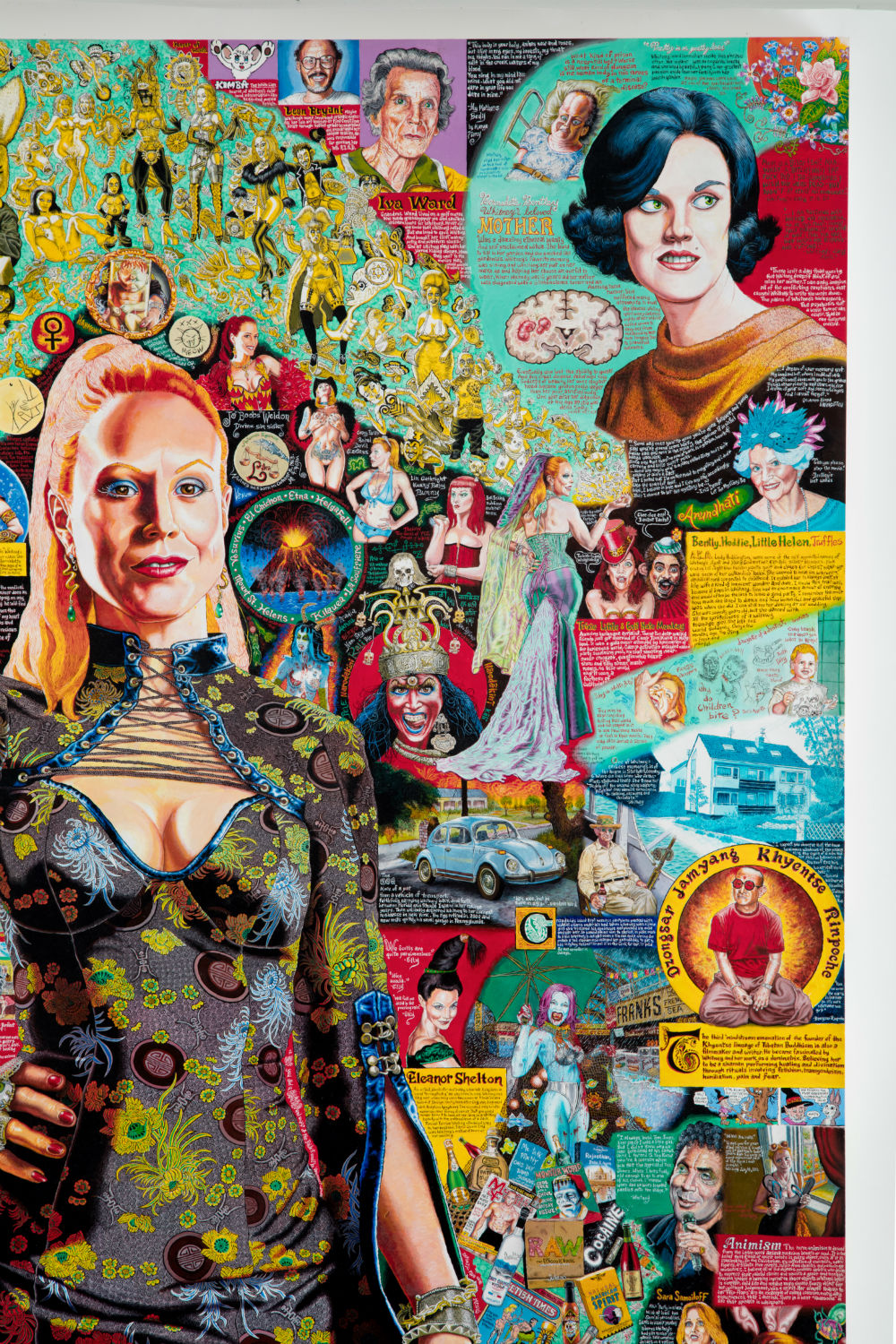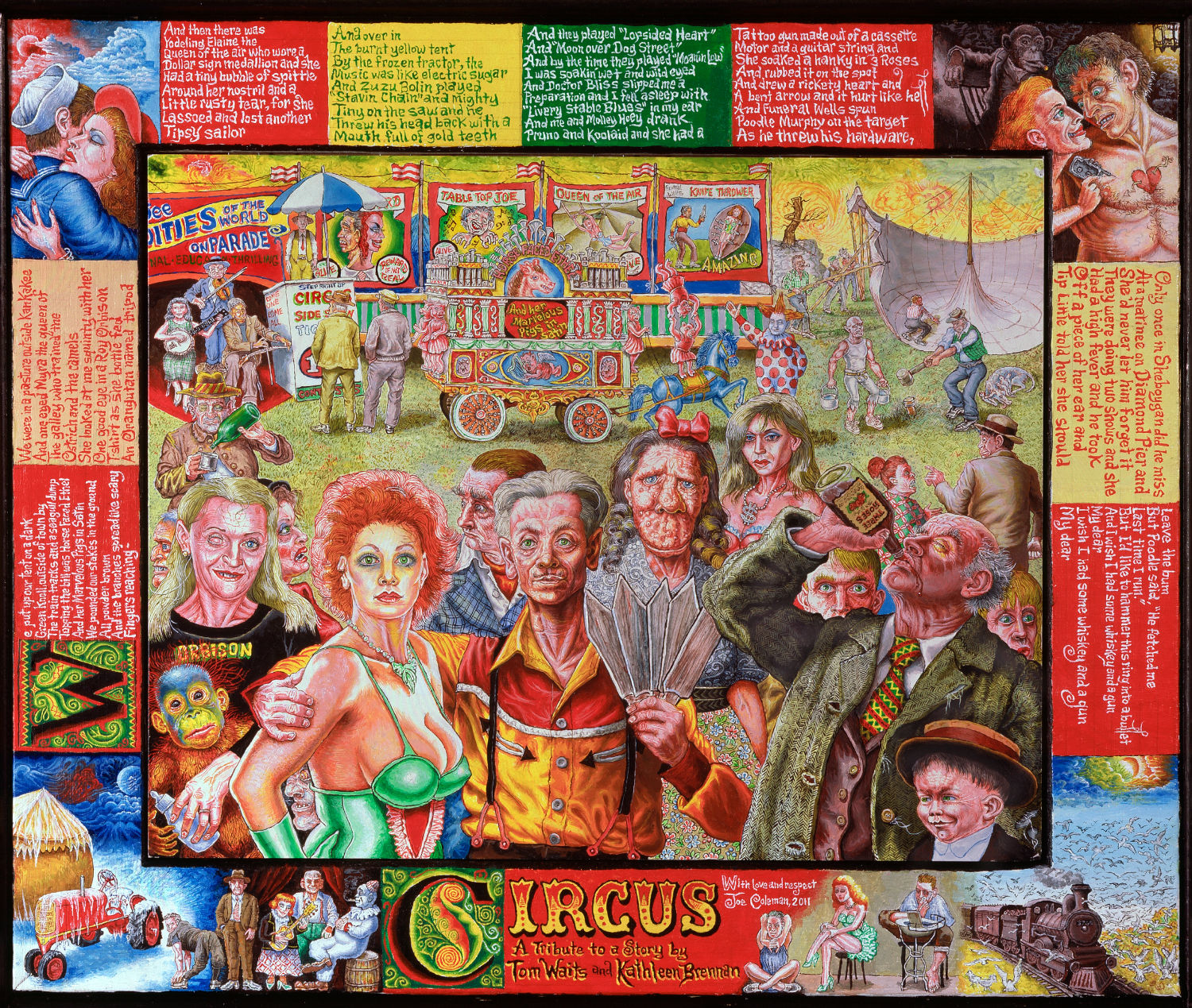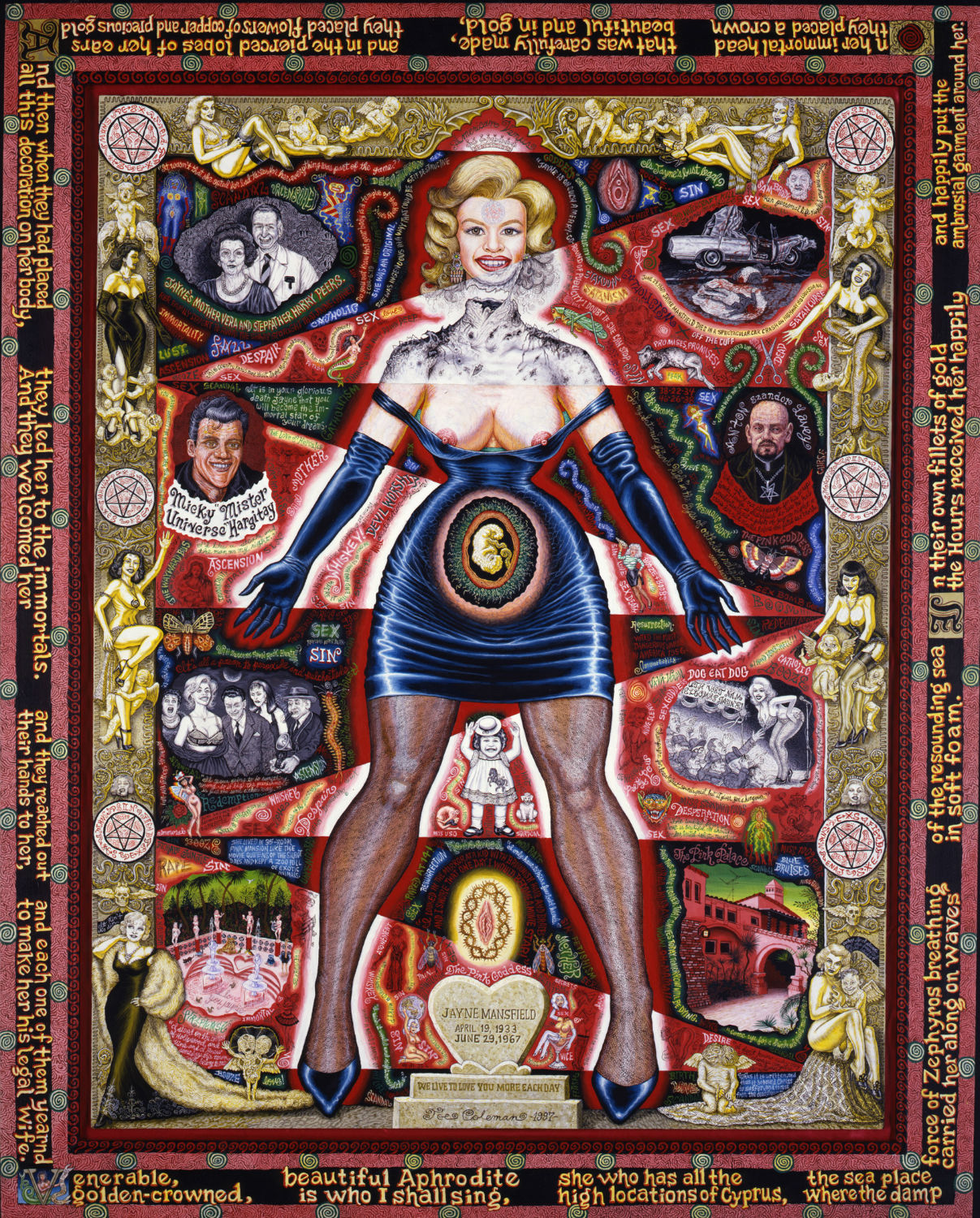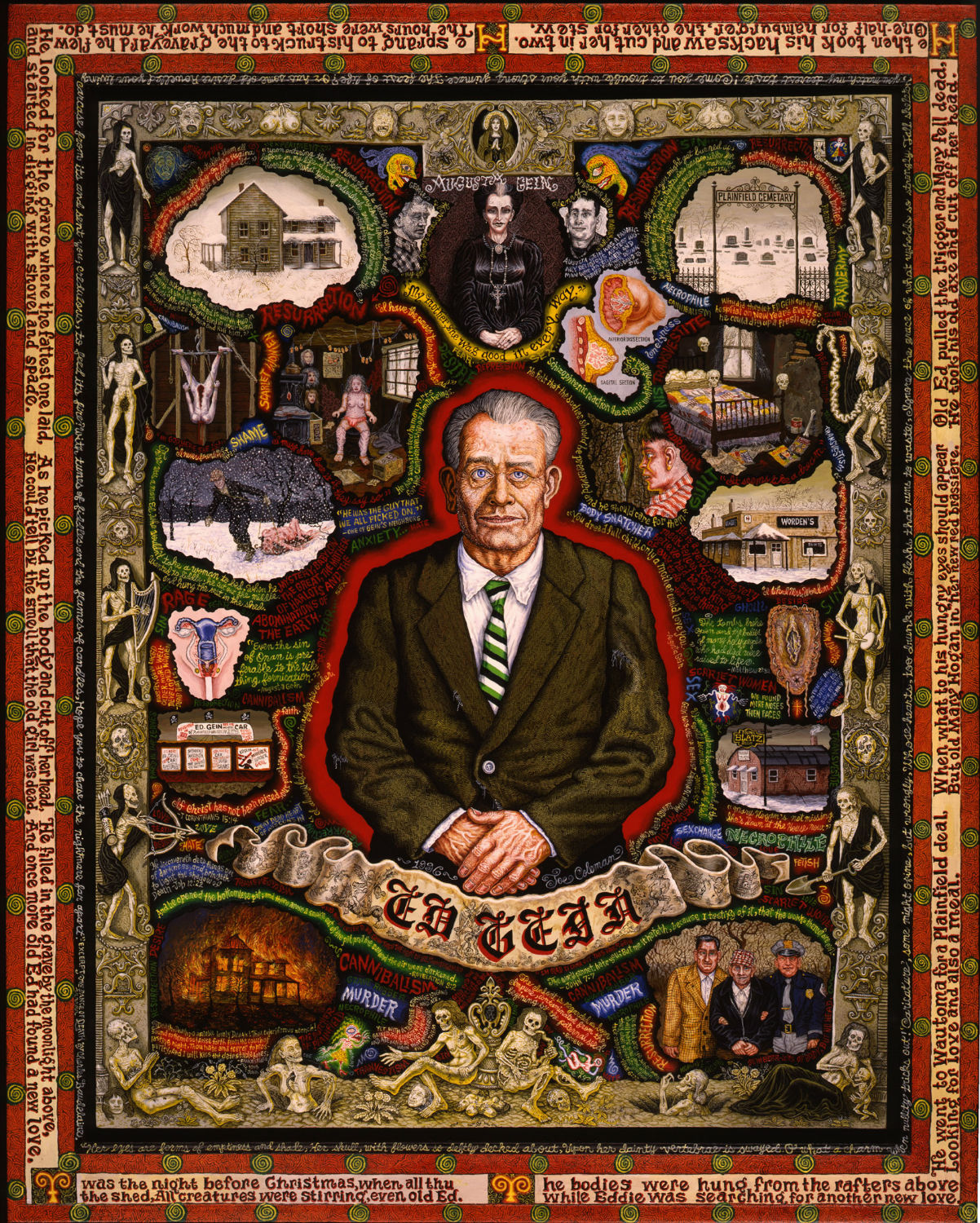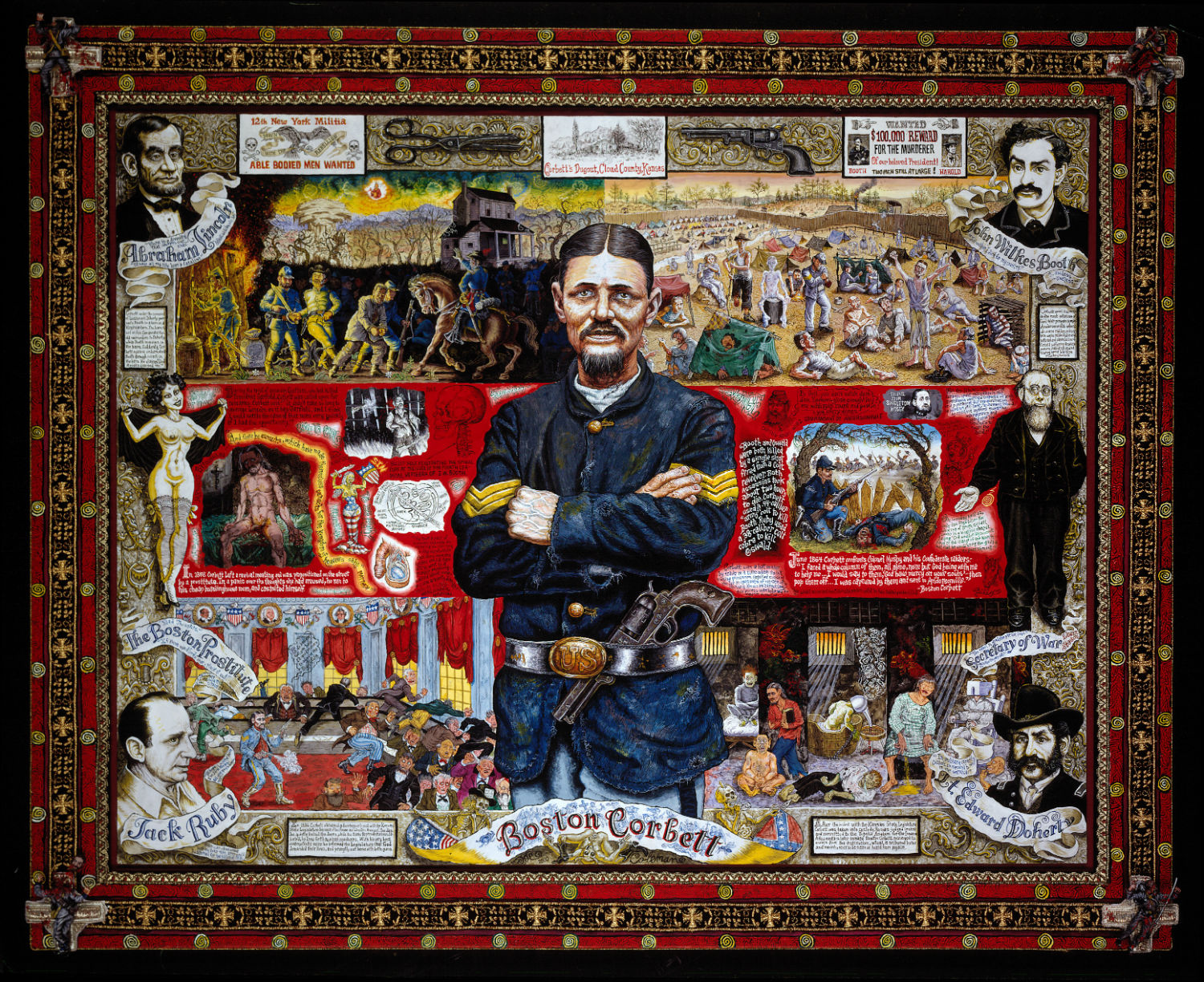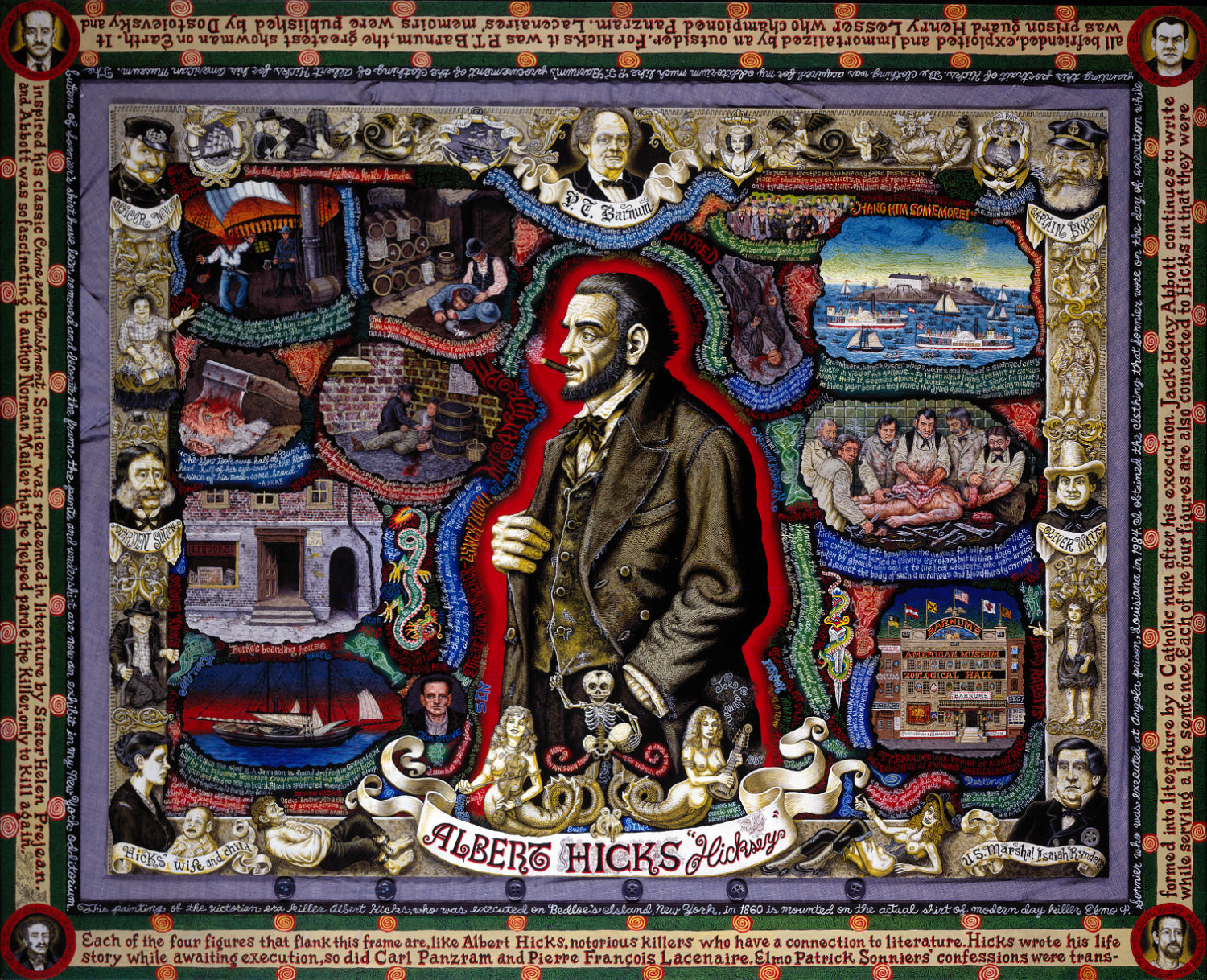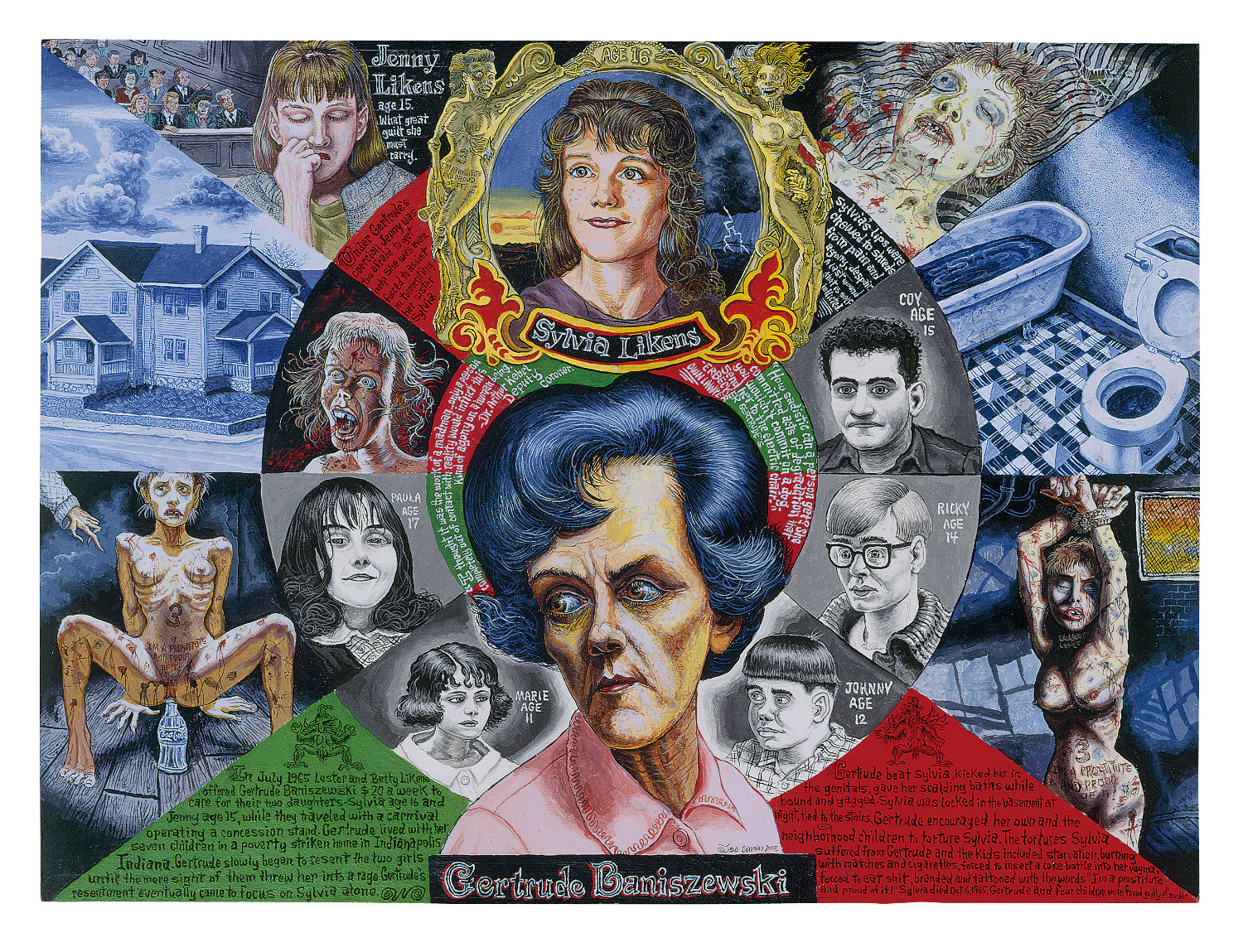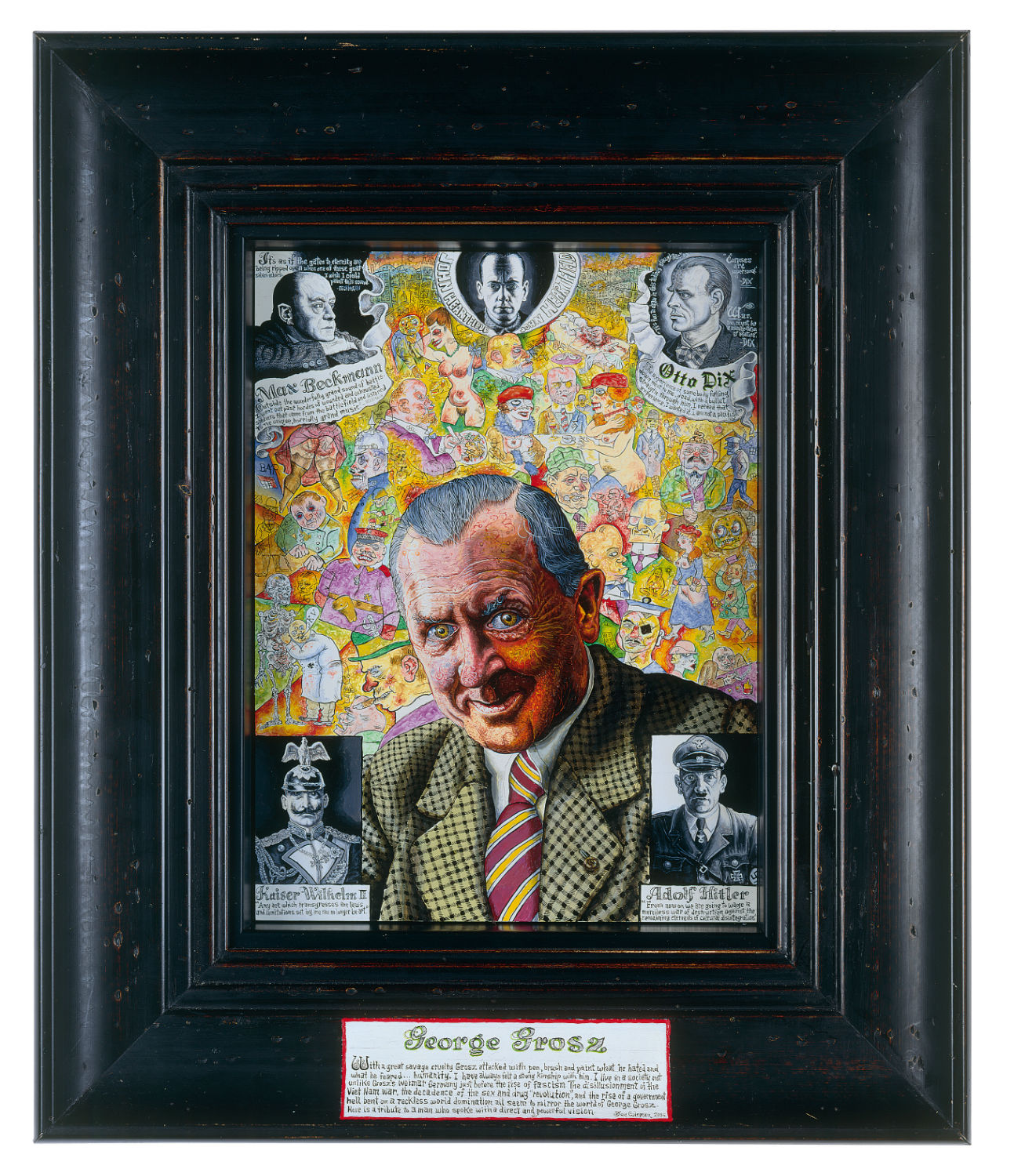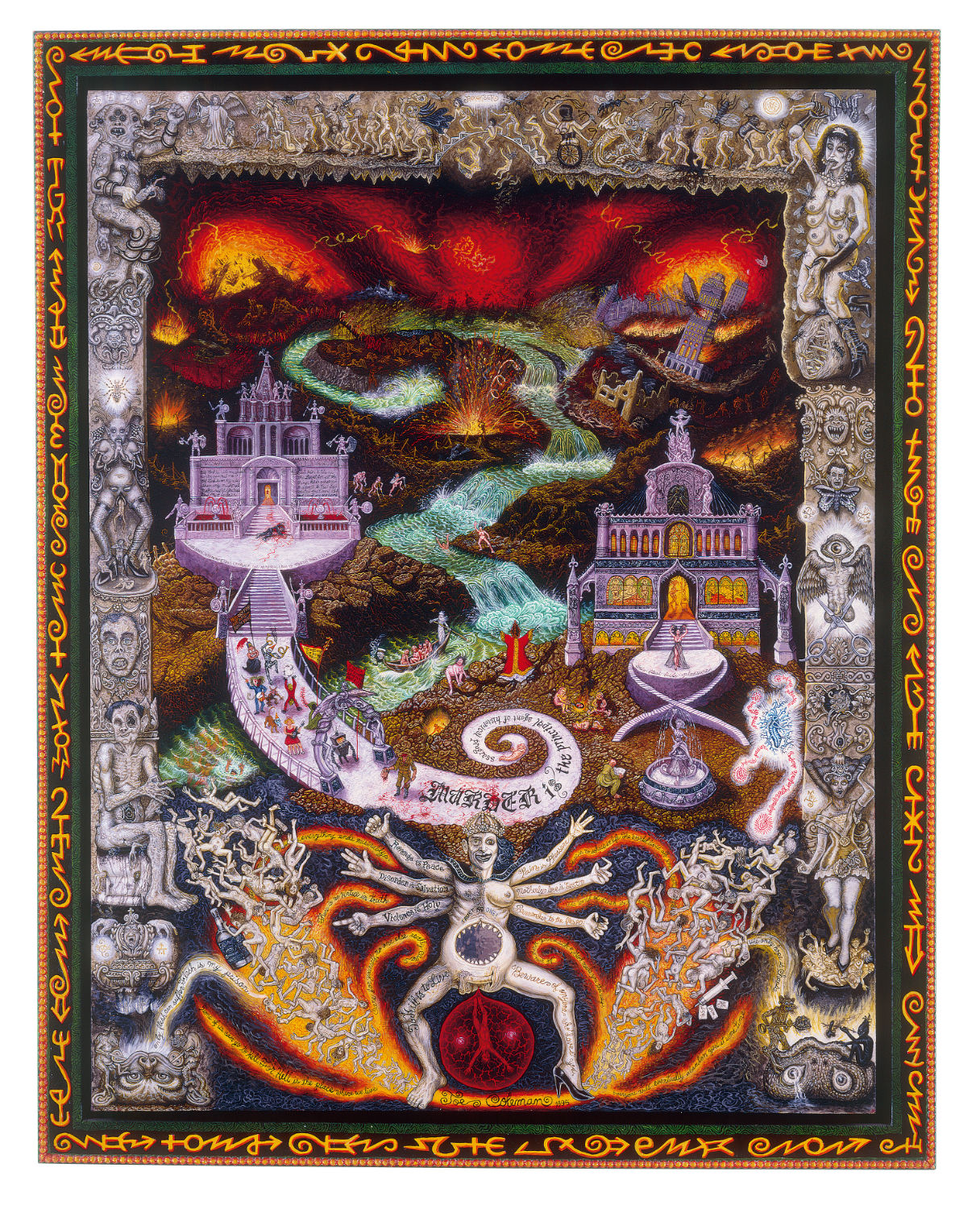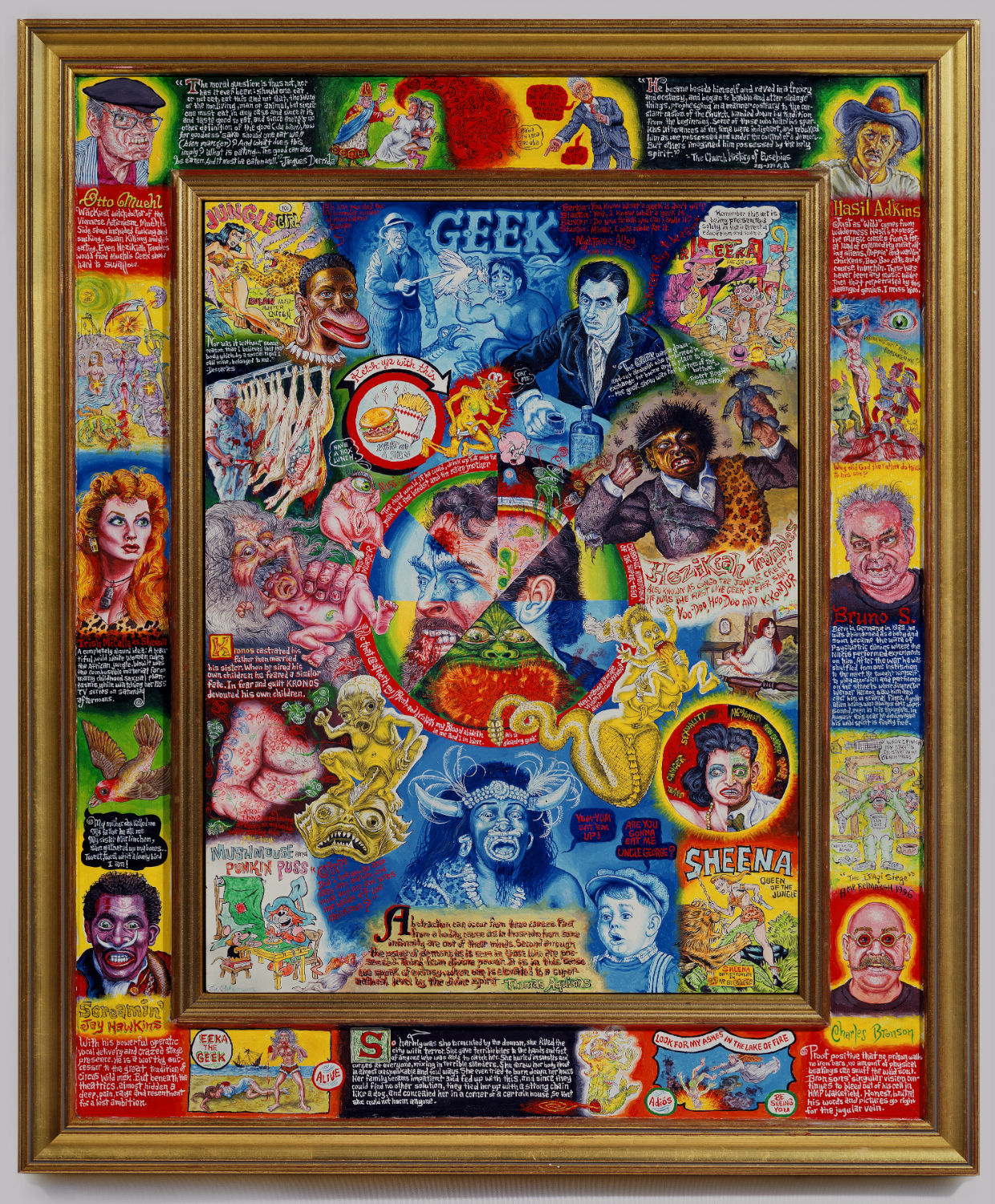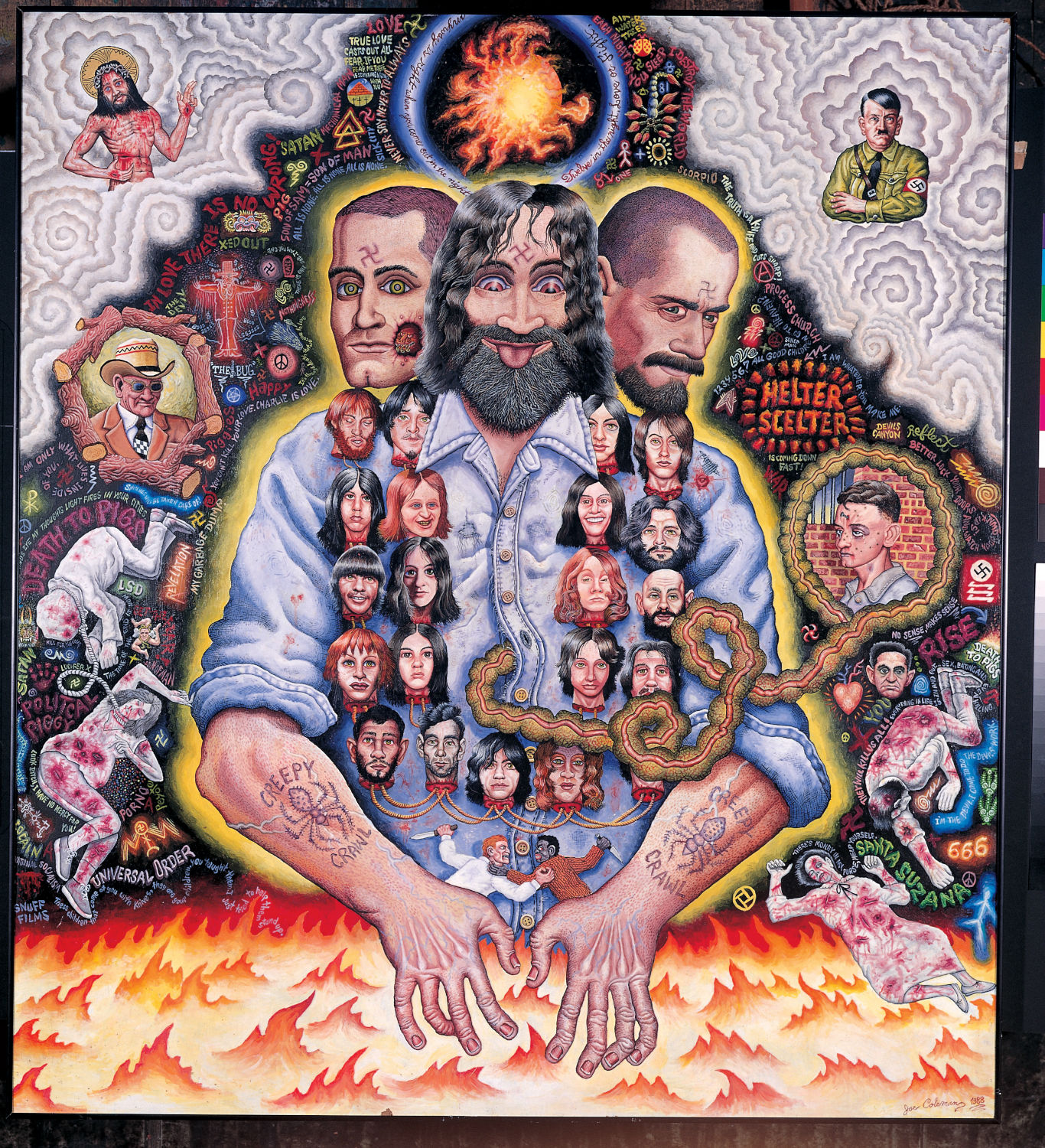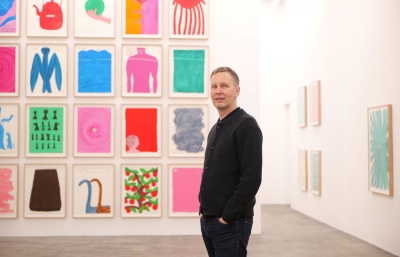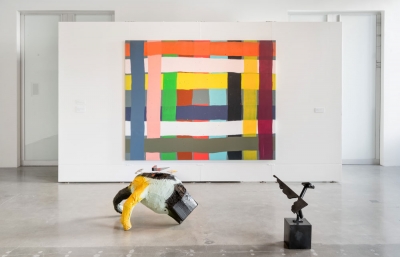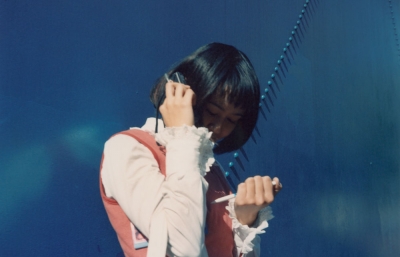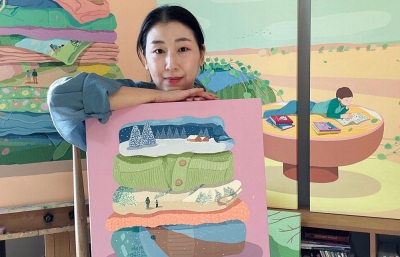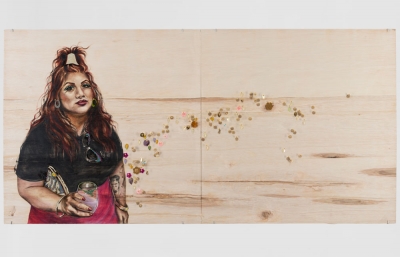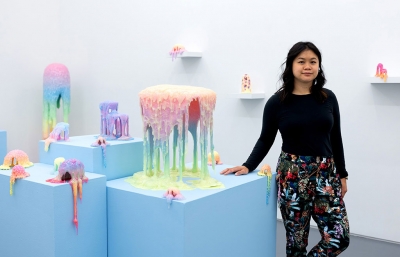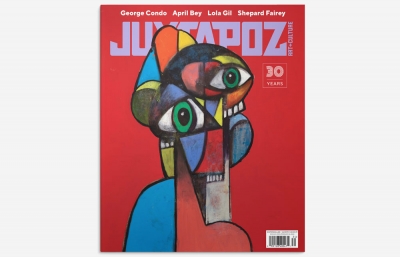Sinister urges lurk within all of us when the portal into the deepest, darkest wellspring of the scorched psyche is unlocked. And only then the shaman turns the key to reveal the unexpected.
It might be cliché to say that acclaimed artist, Joe Coleman, possesses that power with his one-hair paintbrush in hand. His meticulous, intricately detailed, psycho, eye-candy paintings give voice to a ragtag cast. Primarily a portraitist, Coleman paints intense tableaus of those mired in the suffering of the human condition.
Whether heroes like Harry Houdini, George Grosz and Johnny Eck, or notorious villains like Albert Fish and Ed Gein, or intriguing celebrities like Hank Williams and a decapitated Jayne Mansfield, experiencing one of his pictures grips the mind.
Ensconced in his Brooklyn Heights apartment, surrounded by The Odditorium, a museum-grade menagerie of spectacular and shocking objects, Coleman diligently paints lurid narratives that are highly prized by his faithful collectors. For nearly a decade, he has worked on just two epic paintings. Along with a number of important works in a storied career, they comprise his first major survey on the West Coast at Cal State Fullerton’s Begovich Gallery. In anticipation of the exhibition, I spoke to Coleman about the upcoming show, his varied obsessions, and his idiosyncratic painting technique.
Read this feature and more in the April 2017 issue of Juxtapoz Magazine.
Gregg Gibbs: Tell me about the survey exhibition you have coming up at Cal State Fullerton and some of the highlights.
Joe Coleman: The show includes older work going back to the 1980s. The large portrait of Charles Manson will be the earliest piece, and the most recent work will be The Three Graces that I premiered as part of the Desire show at Miami/Basel, which was curated by Diana Widmaier Picasso for Jeffrey Deitch and Larry Gagosian. That encompasses a long period, but it’s only a sampling. The two most important paintings are Doorway to Joe and Doorway to Whitney, which I’ve spent the past eight years working on.
You spent eight years working exclusively on those two portraits?
That’s correct, four years on each one. I built a special chair designed like a guillotine that could go up and down with a crank, inch by inch, so that I could make exact measurements. I’ve been involved with a feature-length documentary that covered the whole process from beginning to end of the Whitney painting. That’s four years of painstaking work, eight hours a day, every day, working one square inch at a time. They were shooting with special lenses that could get in microscopically, so you could amazingly see my brush take up half the screen. The film also includes cameos from people who came into our lives at the time, like Iggy Pop and Hank 3. It will also include the complete tour of my home and collection. There will be a teaser reel for the film in the exhibition.

Portrait by Bryan Derballa
Let’s talk about your process. How do you spend a typical day working, and how do you maintain such focus given the detail in your work?
I don’t pre-sketch, so I don’t necessarily know what I’ll be working on when I start. That way, I can include elements I learn about that day. During the process of making the doorway paintings, I was creating a diary as well as a biography. I wake up around eight o’clock, make some coffee—by eight-thirty, I start painting. I continue, a square inch at a time, and when that’s completed, I add another and another. It grows organically and I really don’t know exactly where it’s going until it’s revealed to me, kind of like an archeological dig—digging inside me even though it’s revealed on the surface. I don’t plan out the composition. I want the painting to tell me what it’s about. It does get scary, but a key process is faith. I’ve got to have faith the thing is going to come together.
I was brought up Irish Catholic. I don’t know if I believe in a lot of the rhetoric that I was spoon-fed as a kid, but a couple of things that stuck were the drama and the ritual, and also this idea of faith. That’s going to take me there, that’s going to reveal itself to me. It’s like a journey, in a way, and it becomes an exploration. I don’t really know where it’s taking me until I finish. The only way I know I’m done with any painting is when I run out of room.
Do you ever go back to alter finished sections, or is it always progressing forward?
I usually don’t go back, but sometimes I do correct it in its current state. I may change what I’ve done that day if it’s not good enough. When I’m working on that square inch, even though it’s been eight hours of working, I might decide that I just don’t like the day’s work. So I’ll sand off the surface and have to repaint it. Occasionally, I’ll go back, but it’s rare. Ninety percent of the time, once I finish that square inch, I move to the next, and it just keeps growing.
Once, a long time ago, I was doing a painting of Quantrill’s Raiders, where I had one of the raiders but didn’t really know what he looked like. I had almost finished the painting when I found this old photograph of him and realized it was different from how I painted him, so I went back and changed him. The times where that has happened, I could probably count on one hand. Once the painting is complete—that’s it.

Do you consider finishing just one square inch for the day a success?
Yeah, that would be a good day.
How did you develop this unique technique?
I think it happened slowly over time. My earlier paintings were a lot looser. Then my hand started moving more minimally, because I was searching for information on the surface. I realized that when I moved my hand more slightly there was something between the two points that the brush stroke made; there was information between that stroke and I could look for more. You have tools in archeology where you can search more minutely in your excavation by trying to search for more information on the surface. I’m always researching for more information. The text is almost as important as the images. The text is sometimes something I’ve heard from someone or some kind of comment that I’m making. Sometimes it’s from a book that I’ve read. The quality is important, too, so the choice of how the text is done is very specific—there are always several layers going on.
You’re known to work with a brush that has a single hair. Can you confirm or deny the rumor that it’s pubic?
[Laughs] I’ve never heard that rumor, but I like it. It’s actually two horse hairs—one hair holds the paint. I use several different brushes at different times, depending on the part of the painting I’m working on. Every single part has the same focus. It’s not that some of the painting is loose and some is tight—it’s all the same, all clinically minute without big brush strokes. I get into this other world working with a jeweler’s magnifying lens to get fine detail and cut off anything else in my surroundings. Working in a very small area becomes your world, so that becomes huge. When you’re spending hours and hours in that little tiny world, it becomes everything. When I step back, it’s like divers getting the bends when they come up too fast. You lose your equilibrium because it’s such a different scale. The transference to normal from a minutia scale is shocking, as if you’re painting with atoms and molecules. When you step back, you’re looking at the microcosm and macrocosm at the same time.

Since your compositions are chock-full of words along with the imagery, do you see yourself as a writer as much as a painter?
I definitely consider myself a writer because they are all narratives, and they do not exist in chronological order. There is no beginning, middle, or end to my paintings, like in a movie or a book. The viewer can choose what they want to see, and each experience of the narrative is different. The more you look, the more is revealed.
I’ve heard from collectors who own your work that, years later, discovered things they had never noticed before.
It’s wonderful when that happens. It means a lot to people when they have a piece and it becomes a member of the family. I know kids who have grown up with a painting their parents hung and how much affection they have for the character in the image, as if it’s a real person.
It sounds like you’re going for absolute freedom.
I guess it’s something that I naturally fell into. It pulled me in. It can be really scary, especially when you’re starting a giant piece. I’m working on this tiny area with all this blank surface around, and I don’t know what’s going to happen, but at the same time, it’s really exciting. I like to be on the edge in everything I’ve done. My whole life seems to be a search for the feeling of walking that tightrope on a cliff.
How do you research your subjects, especially for the biographical pieces?
I used to go to the library and do painstaking research on the historical portraits, and I still do some of that; but the deepest thing I’m looking for is that I want to have some kind of spiritual or emotional connection. I want to identify with the person, kind of like method acting, where you become the character. I also sometimes talk to myself as if I am one of the characters in the painting, and kind of act it out as I’m working, even if it’s a heinous subject, a person of seemingly no redemption. But I don’t make a judgment, and I want to allow them to speak and tell their side of the story. A lot of my search for these dark souls is because of my Catholicism. I was brought up with these images of great model saints who have been beheaded or had their hands cut off. Jesus of Nazareth was nailed to a cross and stabbed in the side after being tortured. That’s only one side of the story. What about the person who was committing that atrocity? What was his story like? What was he going through? One can’t exist without the other. They need each other to exist. To me, they are kind of like the shadow selves of history and religion.

Which brings me to your work about serial killers, death and violence, which you have referred to as “the wounds in American culture.” What drives your interest in celebrating the disenfranchised loser whose darkness might reside in us all?
It might sound strange, but I feel an identification and kind of a responsibility to take care of the losers. I don’t know. If I could psychoanalyze myself, I’d say part of it is, “there, but for the grace of God, go I.” I know I’ve done some terrible things in childhood, and I think I know about what happens when you go down the wrong path and what it can cost you, even things that have happened in my life to dear friends and family. We are all subject to the depths of horror and pain, suffering and rage. It’s within all of us.
As a nation, we are guilty of many sins. We should own those. The genocide of the American Indian was one of the great atrocities, which should fill us with great guilt. Let alone slavery... we have nothing to be on our high horse about. As a nation, we have to come to terms, and I think, to transform that into something beautiful. That’s what I’ve always thought alchemy really is. The alchemists were trying to change base metals into gold, and I’m trying to change the things we’re ashamed of into a kind of beauty and find redemption. These stories need to be told to bring some kind of healing.
The carny world pervades much of your Americana references. What is it about sideshow banners, geeks, gaffs and freaks that provides you with so much enjoyment?
I was raised near Bridgeport, Connecticut, where P.T. Barnum lived. There’s a Barnum Museum there now where his home used to be and a festival once a year. That’s where I saw my first so-called freaks. Seeing these hucksters and con men fascinated me. The whole underbelly was somehow more real in a way than the average world that I was exposed to.
I moved to New York when I was 18 when Times Square was a red light district—you had animal sex movies and hardcore porn there all day, the good old days! I was a taxi driver back then, like Travis Bickle, but the stuff I saw in my taxi was way worse than that movie. I saw one of my favorite geeks there named Hezekiah Trambles, also known as Konga the Witch Doctor, or the Jungle Creep, and he was a big influence. What captured my mind about New York was the seediness. It had a great beauty to it. All the film noir I grew up with, I now saw in living color. It was even richer than I imagined. I would drive my cab and then do these paintings that I call human-scapes.
How did your performances in the early days influence your paintings? Did you do both?
It was simultaneous. When I was driving the cab, I was working in underground comics, like my novel, The Mystery of Wolverine Woo-Bait, which was the beginning of my style. I did that in black-and-white pen and ink with the old quill pens and a brush.
Was the goal of the performances to entertain or to shock people?
Definitely theater, but it wasn’t entertainment. That stuff was primal scream psychotherapy done on stage for the masses. It was foreshadowing things to come, almost like a shaman, but I didn’t know what I was doing—I didn’t know why I was blowing myself up. Now I see it as visions of the future, these days, when people are really doing it. I was creating this atmosphere where this character showed visions of what things would be, like an episode of The Twilight Zone. In hindsight, I didn’t know that this would happen.

Are you referring to the terrorist attacks that occur on an almost regular basis these days?
Yeah. Now, everybody and their Aunt Mabel is getting into the act. It was theater, and the symbols were there. Art can be insightful about things that might happen in the future, by not being aware mentally, but spiritually and emotionally—something that’s going on and allowing that thing to express itself. It was a subconscious act as if you’re looking through a telescope into the future.
When I was working as the production designer on Rob Zombie’s “House of 1000 Corpses,” I based the set for Captain Spaulding’s Museum of Monsters and Madmen on photos of your museum, the Odditorium. How did your collecting obsession begin?
I think it started in childhood—collecting monster models, reading Famous Monsters of Filmland, Civil War cards, Mars Attacks cards, play sets of World War II. One of my other obsessions was The Addams Family. McDougal’s House of Horrors from Abbott and Costello Meet Frankenstein had an influence on my home décor. In a way, I’ve made a giant playground of my personal obsessions. It takes up the whole apartment, and I also filled a storage unit.
Are some of the things in your collection gaffs, meaning not the real thing?
It depends. I like gaffs and a good fake, too. A good fake can be as good as the real thing. Like my Fiji Mermaids—I own one from Jack Lambert, who was a ticket agent for Barnum, which dates really far back. It’s a stuffed monkey attached to a fish that has other accoutrements like human hair.
What will happen to the collection when you’re no longer with us?
I’d like to see it preserved like Edgar Allen Poe’s house. I’d like to see it kept in this building, but if not, I’d like it to create the same atmosphere and set it up the same way. It would be nice to have a permanent place where someone will take care of it. I feel sad that Forrest Ackerman’s collection wasn’t taken care of properly. We were trying to set up a show at a place called the Morbid Anatomy Museum in New York, but it closed. A catalogue was created, which will be released once we find a new venue that has the proper historical context. But when you’re dead, you have no control over what the future holds.
Not only did you paint Doorway to Joe, you created a companion piece called Doorway to Whitney. Tell me about your wife, Whitney, and her influence on your work.
I feel blessed and very fortunate to have her in my life, almost like a gift given to me for the hard work that I’ve done on the planet. To have someone as beautiful as she is, that totally gets me without having to explain anything—to have a soul that you care so much about. We finish each other’s sentences and I can be myself with her. I’ve had a lot of other relationships, but never one quite like this. Being alive really has its good points when you experience that. I feel so bad for people who haven’t had that in their lifetime. She’s definitely been an inspiration to my work since we’ve been together.
Do you sell everything you make or do you hold on to some of your work?
I would sell everything, but Whitney makes sure to keep some... even though I raised the little bastards and want them to get out into the world, to leave the nest and go out on their own after I give them life.
Joe, is it true that God is in the details?
Well, first off, you have to define God. I am interested in spirituality, but the term God gets misused so often that I mistrust the word. Even the word “art” gets thrown around too easily. But in the details, I search for spirituality. I know that there are many things bigger than I am, that’s for sure. There is an order to the universe. The first place to look is in the minute places—you have to start with the tiniest thing, then grow from there. My whole life is a search. I have an obsession with duality, the idea of good and evil, and male and female. When we were created, we were separated, but we need each other. All these things show a kind of order—there is even an order to chaos. When I’m painting, there is an order that forces itself onto the surface. It appears, it doesn’t need me to interfere, and that’s very interesting. I allow that force to show me where to go. It’s a journey where I learn and it leads to more questions. I want to keep my mind open. I want to spend the rest of my life learning.
Joe Coleman’s exhibition at Cal State Fullerton’s Begovich Gallery will be on view from April 8–May 20, 2017.
----
Originally published in the April 2017 issue of Juxtapoz Magazine, on newsstands worldwide and in our web store.

